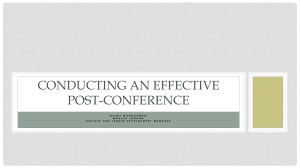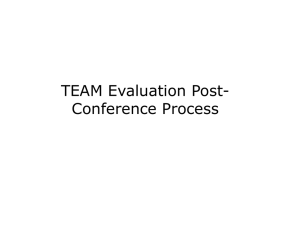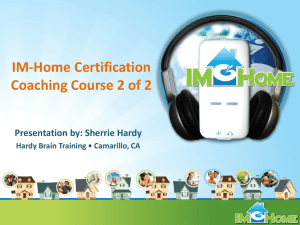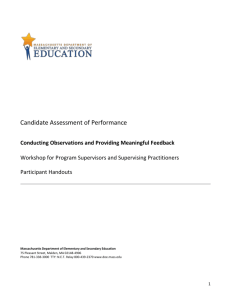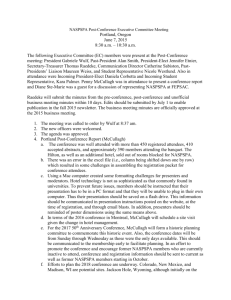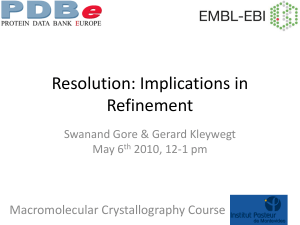OTES Day Two - Northwest Ohio Educational Service Center
advertisement
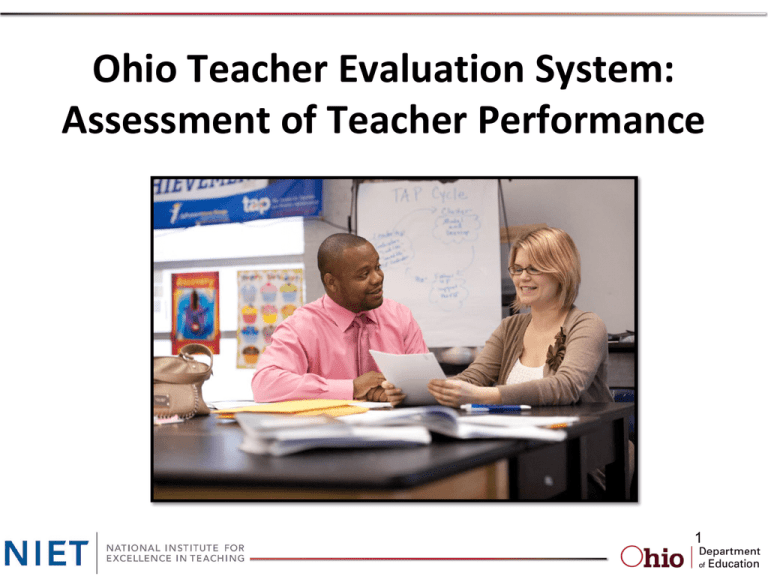
Ohio Teacher Evaluation System: Assessment of Teacher Performance January xx , 2012 1 Welcome to Day 2 Training! Ohio Teacher Evaluation System (OTES) • Settle in • Read pages 6-16 from your handbook • We’ll get started shortly! 2 Agenda for Day 2 Review previous learning and set daily objectives Evidence categorization activity, scripting reminders 4th grade math video Categorize evidence and assign ratings Break Group chart/present and debrief process Debrief “Think aloud” refinement (I do); choose and write up Reinforcement (You do) LUNCH 3 Agenda for Day 2 Watch 4th Grade ELA Lesson Categorize and rate 2 areas (I do + You do) Share out Break Discuss Reinforce/Refine, choose with partner View Refinement, discuss Debrief Wrap up and reflections 4 Training Objectives • • • • Understand and apply the observation processes (preconference, observation/professional project, postconference) presented from the Teacher Performance OTES framework component. Move towards a conceptual understanding of the framework. Accurately categorize and assign performance levels for standard areas from the rubric. Plan, deliver and evaluate a post-observational conference. 5 Reflections • We will share reflections from Training Day 1. • You will be asked to do the same thing at the end of the day today. • See if your area of comfort changes throughout the day! 6 Scripting Reminder When capturing evidence, these strategies will help you collect accurate and defensible notes. During the lesson: 1. 2. 3. 4. 5. Time: Capture the length of different segments of the lesson Abbreviate: When possible abbreviate; after the lesson write out what you abbreviated Verbatim: Capture verbatim dialogue when possible Paraphrase: Use parentheses to indicate paraphrasing Circulate: Move around the class as needed to hear teacher and students and to see student work After the lesson: 6. 7. 8. 9. Upfront Summary: After you finish, go through the evidence and write a brief summary of the lesson Q & F: Shorthand for questions and feedback, go through the evidence and label Label: Begin categorizing your notes by labeling evidence for the standard area Lesson Analysis: Identify the lesson’s primary objective 7 When do you collect evidence? Prior to the lesson being observed Pre-Conference •Review of lesson •Generate questions from lesson plan During the lesson What the teacher says and does What the students say and do After the lesson Post-Conference Communication between classroom observation and post-conference 8 View Video 4th Grade Math 40 minutes As you watch the video, please remember to script in order to effectively categorize evidence and assign performance levels for Lesson Delivery, Differentiation, Resources, Classroom Environment, and Assessment of Student Learning. 9 Categorizing Evidence & Assigning Ratings (I Do) • Using the Scoring and Evidence template provided, listen as I model how to categorize evidence from this lesson for: – Lesson Delivery • Listen for the following: – Questions the trainer asks him/herself – Decisions made for how to categorize the evidence – How ratings are assigned based on the evidence categorized 10 10 Minute Break 11 Evidence and Rating (We do) With a shoulder partner, take 25 minutes to categorize all relevant evidence and assign performance ratings for Differentiation, Resources, Classroom Environment, and Assessment of Student Learning. Remember the questions that the trainer asked themselves when they categorized and rated their evidence. 12 Evidence and Rating (We Do) As a table, take 15 minutes to reach consensus on the evidence and performance rating for the area assigned by the trainer and compile the evidence on chart paper. At the bottom of your chart paper, reach consensus as a group and assign a performance rating. 13 Group Presentations We will share out evidence, then share performance ratings. Groups will get 3 minutes each to share their evidence/ratings. Everyone else should be listening for the following: 1. Is all of the evidence objective? 2. Does the evidence match up with the rating given? 3. Is there verbatim dialogue included (what teachers said/students said?) 14 Debrief What are the major takeaways from the categorizing/rating process? 15 Choosing an area of Refinement (I Do) and Reinforcement (You do) 1. What area will have the most impact on this teacher’s pedagogy? 2. What is the most appropriate type of feedback for this teacher and his/her current capacity? 3. What has been reinforced/refined before? 4. Do I have ample evidence to support this area? Reminder: Your reinforcement is JUST a reinforcement. There should be no qualifying statements such as “it would be better if” or “to make this even more effective…” 16 LUNCH 17 When do you collect evidence? Prior to the lesson being observed Pre-Conference •Review of lesson •Generate questions from lesson plan During the lesson What the teacher says and does What the students say and do After the lesson Post-Conference Communication between classroom observation and post-conference 18 4th Grade ELA Lesson Plan Before we watch our third lesson, take a moment to look over the lesson plan. Please remember that we are not “grading” the lesson plan. Ask yourself: 1. 2. What evidence do I already have (you still have to make sure it aligns with what you see in the lesson)? Mark these on the plan itself. What questions does this lesson plan leave me with? Think of three and write them down. 19 View Video 4th Grade ELA 46 minutes As you watch the lesson what do you need to be doing? Capturing Evidence! 20 Lesson Activity Directions: Each group will need to categorize and rate 2 areas as assigned by trainer. Take 10 minutes to individually compile your evidence. Take 10 minutes to agree upon evidence & rating with your group. Divide into groups of 3 with the following roles: 1. Keeper of the Rubric – ensures the evidence is appropriate for the specific area/standard 2. Value Statement Police – makes the group aware when someone uses value statements 3. Chart Creator – will synthesize the evidence and record on the chart 21 Remember—Collecting and Categorizing Evidence: Language to Avoid Avoid the use of the following language: •Value Statements: • I think… •I feel… •She should have… •She could have… •When I taught this, I … The discussion about the lesson should be based on the evidence and the rubric. 22 Lesson Activity Directions: • Groups will share out their categorized evidence, and then their ratings. • While other groups share, please capture their evidence on your categorization sheet so by the end you have a whole lesson categorized. 23 10 Minute Break 24 When do you collect evidence? Prior to the lesson being observed Pre-Conference •Review of lesson •Generate questions from lesson plan During the lesson What the teacher says and does What the students say and do After the lesson Post-Conference Communication between classroom observation and post-conference 25 Four Key Elements of the Instructional Post-Conference 1. Introduction/Greeting/Establish Length • Review Conference Process • General Impression Question - “How do you think the lesson went?” 2. Reinforcing the Teacher • Identify an area of Reinforcement (ONLY one area) • Ask Self-Analysis Question • Provide evidence from notes 26 Four Key Elements of the Instructional Post-Conference 3. Refining the Teacher’s Skill: • Identify an area of Refinement (ONLY one area) • Ask Self-Analysis Question • Provide evidence from notes • Give a recommendation for future practice 4. Present evidence and rating connected to the rubric 27 Reinforcement and Refinement (You Do) Individually: Choose an area of Reinforcement and Refinement for this teacher. (5 minutes) Remember the guiding questions: 1. What area will have the most impact on this teacher? 2. What is the most appropriate type of feedback for this teacher and his/her current capacity? 3. What has been reinforced/refined before? 4. Do I have ample evidence to reinforce/refine this area? Be ready to answer all 4 questions with your partner! (5 minutes) 28 Reinforcement and Refinement With a Partner: Discuss your areas of Reinforcement and Refinement. (5 minutes) 1. What area will have the most impact on this teacher? 2. What is the most appropriate type of feedback for this teacher and his/her current capacity? 3. What has been reinforced/refined before? 4. Do I have ample evidence to reinforce/refine this area? 29 Watch Post-Conference Refinement 10 min As you watch the refinement portion of this post-conference, consider the following questions: 1. What would make this portion more effective? 2. What would you do differently? 3. From your experience, are there elements of this refinement that are missing? Please script while you watch and then you will discuss the above questions with a shoulder partner. 30 Watch Post-Conference Refinement 10 min 31 Debrief 1. Why was this portion not as effective as it could be? 2. What would you do differently? 3. From your experience, are there elements of this refinement that are missing? 32 Four Key Elements of the Instructional Post-Conference 1. Introduction/Greeting 2. Reinforcing the Teacher (Relative Lesson Strength) 3. Refining the Teacher (Relative Lesson Weakness) 4. Present Evidence and Rating Connected to the Rubric 33 Training Objectives • • • • Understand and apply the observation processes (preconference, observation/professional project, postconference) presented from the Teacher Performance OTES framework component. Move from a procedural to conceptual understanding of the framework. Accurately categorize and assign performance levels for Standard Areas from the rubric. Plan, deliver and evaluate a post-observational conference. 34 Self-Reflection Please complete the following on a self-reflection sheet: – From today’s training, I am most comfortable with _________. – From today’s training, I am least comfortable with _________. – My one question is ___________. 35 Wrap-Up and Questions ? 36 THANK YOU! 37
